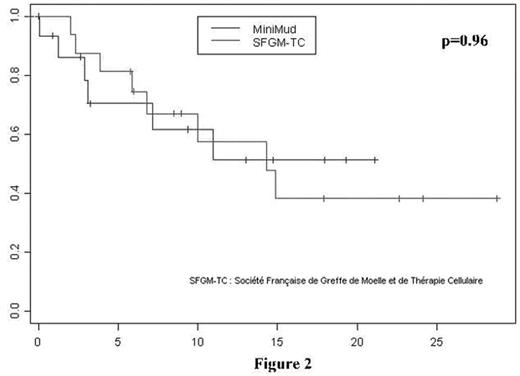Abstract
This prospective multi-center trial (MiniMud) concerns 27 patients (13 females, 14 males - 56 years[18–65]) who underwent allogeneic hematopoietic stem cell transplantation (HSCT) from unrelated donors. The diagnosis and disease status pre-transplant were AML (n=12; 5 CR1, 7 CR2), ALL (n=1; 1 CR2), MM (n=5; 3 PR2,1 PR3, 1 PR4), NHL (n=4; 1 CR1, 2 PR3, 1 PR4), MPS (n=3; 2 stable disease (SD), 1 Relapse), acute RAEB (n=1; 1 progressive disease (PD) and CLL (n=1; 1 PR2). In total, 14 patients were in CR, 9 in PR, 2 in SD, 2 in PD. The median interval between diagnosis and transplant was 27 months [5;171], 24 patients received PBSC and 3 received bone marrow from unrelated 10/10 antigen HLA-identical (high-resolution level). All patients received Fludarabine 30 mg/m2/dx5d, Treosulfan 12 g/m2/dx3d and ATG 2,5 mg/kg/dx3d. After transplant, we observed 2 graft failures, 7 patients developed an AGVHD ≥ grade II (30%). Only 23 patients were eligibile to be analysed after 3 months of follow-up post transplant, 7 patients developed cGVHD (30%) (5 limited and 2 extensive), 12 patients died (7 from TRM causes and 5 from relapse) and 12 patients are alive in CR with a median follow-up of 14 months. Among the global population we defined a low risk subgroup: 17 patients [12 AML (5 CR1, 7 CR2), 1 ALL (CR2), 3 MM (3 PR2) and 1 NHL (CR1)], 2 patients presented an AGVHD ≥ grade II (13%). With a median follow-up of 18 months, 2 patients had a follow-up of less than 3 months, 3 patients developed a cGVHD (20%), 6 patients died (40%) and 9 patients are alive in CR. At one year, the probability of overall survival (OS) and event-free survival (EFS) were 50.4% [32;79], 40% [23;70] for the total population and 60% [37;96], 51.5% [29;90] for the low risk subgroup respectively. To try to demonstrate if Treosulfan allowed a better transplant outcome we performed a paired match-analysis [center and 4 out of 5 other parameters (age, gender, HSC, pre-transplant status and diagnosis] comparing our Treosulfan series and RIC transplants receiving Fludarabine, Busulfan and ATG (2.5–12.5mg/kg) from the SFGM-TC registry. This paired match-analysis found only RICT from related donors in the SFGM-TC database and showed no difference in term of OS and EFS between our unrelated donor-Treosulfan and related donor-SFGM-TC series.
Figure
Figure
In conclusion, these results demonstrate that Treosulfan appears to be a very promising drug that could be included in the conditioning regimen before HSCT from either related or unrelated donors.
Author notes
Disclosure: No relevant conflicts of interest to declare.



This feature is available to Subscribers Only
Sign In or Create an Account Close Modal